India’s cultural tapestry is richly woven with the threads of history, spirituality, and architectural brilliance. One of the most remarkable facets of this tapestry is the presence of rock-cut cave temples. These architectural marvels, meticulously hewn from solid rock, have stood the test of time and offer us a glimpse into the country’s ancient artistry and religious devotion. In this article, we will embark on a fascinating journey to explore 12 of the most iconic rock-cut cave temples in India. Each of these caves has its unique story to tell, steeped in history, and adorned with breathtaking sculptures and carvings.
Ajanta Caves: The Artistic Masterpieces
Location: Maharashtra
The Ajanta Caves, situated in the state of Maharashtra, are an epitome of artistic excellence. These 30 rock-cut caves, dating back to the 2nd century BCE, are a UNESCO World Heritage site, and rightly so. The caves are adorned with exquisite Buddhist paintings and sculptures, showcasing the zenith of ancient Indian artistry. As you wander through the dimly lit corridors, you’ll be transported to a world where devotion and creativity meld seamlessly.
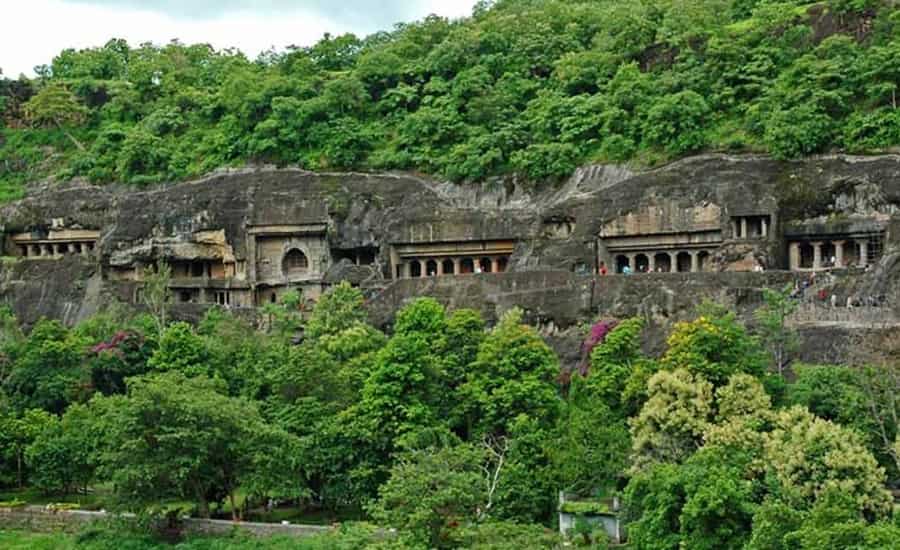
The Ajanta Caves, located in the Sahyadri Hills, are renowned not only for their architectural beauty but also for their historical significance. Carved into the rocky terrain, these caves are a treasure trove of ancient Buddhist artistry. Each cave tells a story through its intricate paintings and sculptures, depicting the life of Buddha and various other tales from Buddhist scriptures. The vibrant frescoes that adorn the walls are a testament to the skill and dedication of the artists who created them.
Beyond their artistic significance, the Ajanta Caves offer a glimpse into the spiritual practices of ancient India. As you explore the dimly lit chambers, you can feel the aura of tranquility that permeates these spaces. The grandeur of the stupa halls and the serenity of the prayer rooms make it evident that these caves were not just places of worship but also centers of meditation and contemplation. Visiting the Ajanta Caves is like taking a step back in time to witness the spiritual devotion and artistic brilliance of an era long gone.
Ellora Caves: The Divine Trilogy
Location: Maharashtra
A short distance from the Ajanta Caves lies another treasure trove of rock-cut wonders – the Ellora Caves. This UNESCO World Heritage site is a testament to India’s religious diversity and architectural brilliance. Comprising 34 caves, the Ellora Caves house temples representing Buddhism, Hinduism, and Jainism. The crowning jewel is the Kailash Temple, a monolithic wonder carved out of a single rock. It’s not just a temple; it’s a symphony of faith etched into stone.
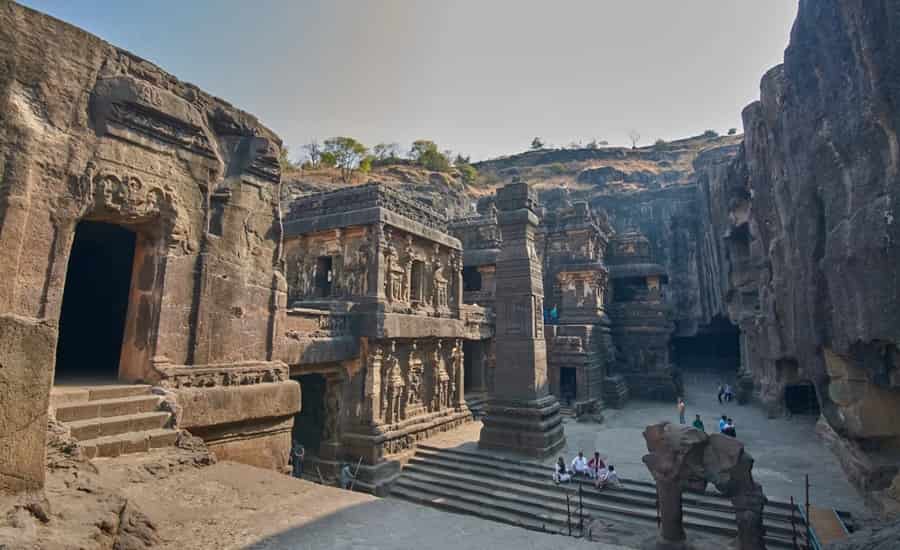
The Ellora Caves, with their intricate carvings and monolithic structures, are a testament to the devotion and craftsmanship of ancient artisans. These caves offer a unique blend of religious harmony, where you can find Hindu, Jain, and Buddhist temples coexisting peacefully. The Kailash Temple, dedicated to Lord Shiva, stands as a masterpiece of rock-cut architecture. Its colossal size and intricate detailing leave visitors in awe of the human ingenuity that went into creating it.
Beyond the architectural grandeur, the Ellora Caves provide a spiritual experience like no other. As you explore the dimly lit chambers and marvel at the intricately carved pillars, you can’t help but feel a sense of reverence. Each cave tells a story, not just of the deities they are dedicated to but also of the religious tolerance that prevailed in ancient India. The Ellora Caves are a testament to the idea that different faiths can coexist harmoniously, a message that resonates even in today’s world.
- Suggested Tour: Ajanta Ellora Caves Tour Packages
Badami Caves: Chalukyan Splendor
Location: Karnataka
Moving south to Karnataka, we encounter the Badami Caves, a testament to the Chalukyan dynasty’s architectural prowess. Carved into the sandstone cliffs, these caves exude a sense of grandeur. They offer a unique blend of rock-cut artistry and Dravidian architecture. The intricately detailed sculptures and cave temples dedicated to Lord Shiva and Vishnu are a sight to behold.
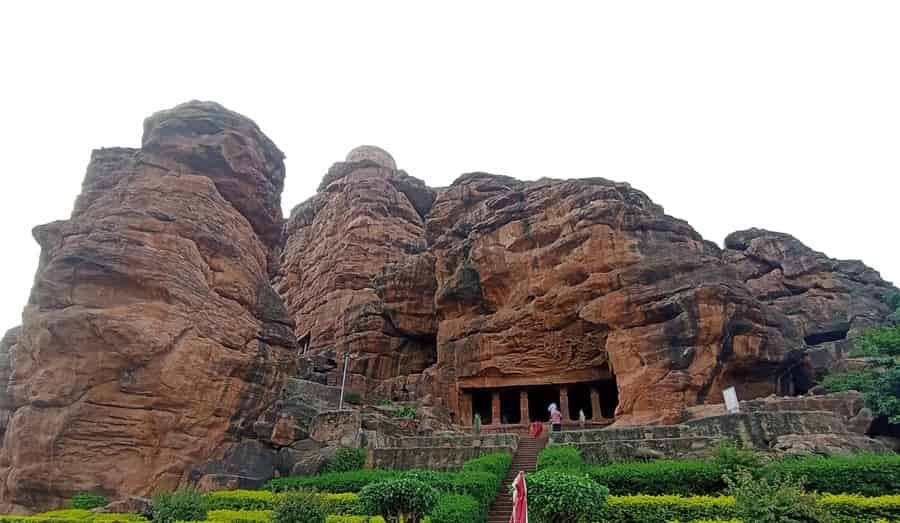
The Badami Caves, set against the backdrop of crimson sandstone cliffs, are a striking testament to the architectural brilliance of the Chalukyan dynasty. These four caves, dedicated to different deities and purposes, stand as an example of the religious diversity that thrived in ancient India. The cave temples, dedicated to Lord Shiva and Lord Vishnu, showcase intricate carvings and detailed sculptures that narrate stories from Hindu mythology. As you explore these caves, you can’t help but admire the skill and dedication that went into creating them.
Beyond their religious significance, the Badami Caves offer a glimpse into the socio-cultural life of the Chalukyan era. The intricately detailed sculptures not only depict gods and goddesses but also everyday life, from dancers to musicians. It’s like walking through a time portal that transports you to an age where art, religion, and culture thrived in harmony. The Badami Caves are not just an architectural marvel but also a window into the vibrant tapestry of ancient India.
Elephanta Caves: Mysteries on an Island
Location: Mumbai, Maharashtra
Perched on an island in Mumbai’s harbor, the Elephanta Caves beckon with their enigmatic aura. These caves house magnificent sculptures dedicated to Lord Shiva. The grandeur of the colossal Trimurti statue, representing Lord Shiva as the creator, preserver, and destroyer, is simply awe-inspiring. The Elephanta Caves offer a glimpse into the spiritual tapestry of ancient India.

The Elephanta Caves, situated on Elephanta Island, are a testament to the profound devotion to Lord Shiva that prevailed in ancient India. The highlight of these caves is undoubtedly the colossal Trimurti sculpture, a masterpiece of rock-cut artistry. This three-faced representation of Lord Shiva is not only awe-inspiring but also thought-provoking, symbolizing the cycle of creation, preservation, and destruction. As you stand in front of this majestic sculpture, you can feel the spiritual energy that emanates from it.
Beyond the Trimurti sculpture, the Elephanta Caves are adorned with intricate reliefs and sculptures that narrate stories from Hindu mythology. The dimly lit chambers create an atmosphere of mystique and reverence. Visiting these caves is like embarking on a spiritual journey, as you navigate the labyrinthine passageways and contemplate the profound symbolism of the artistry. The Elephanta Caves are not just a historical site but also a place where one can connect with the spiritual essence of India.
Udayagiri and Khandagiri Caves: Jain Abodes
Location: Odisha
Journeying to the eastern part of India, we arrive at the Udayagiri and Khandagiri Caves in Odisha. These caves, dating back to the 2nd century BCE, served as residential blocks for Jain monks. They are adorned with intricate carvings, inscriptions, and austere chambers. Exploring these caves is like stepping into the daily lives of the ascetics who once called them home.
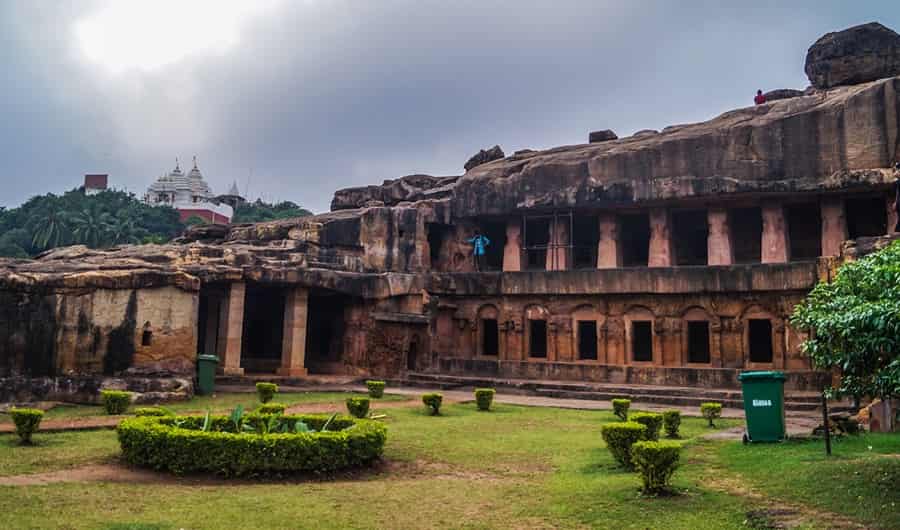
The Udayagiri and Khandagiri Caves are a testament to the ascetic way of life practiced by Jain monks in ancient India. These caves served as monastic retreats, and each cave has its unique purpose. As you explore these caves, you’ll come across inscriptions that provide insights into the lives of the monks who resided here. The intricate carvings on the cave facades depict various aspects of Jainism and showcase the artistic finesse of the craftsmen.
Beyond their historical and religious significance, the Udayagiri and Khandagiri Caves offer a tranquil escape from the hustle and bustle of modern life. The serenity that envelops these caves, nestled amidst lush greenery, makes them an ideal place for introspection and contemplation. The ascetics who once lived here found solace in these rocky abodes, and even today, visitors can experience a sense of peace as they wander through the chambers and courtyards of these ancient caves.
Karla Caves: Buddhist Tranquility
Location: Maharashtra
Nestled in the Western Ghats, the Karla Caves stand as a testament to Buddhist devotion and architectural finesse. These caves, dating back to the 2nd century BCE, house the largest Chaitya hall (prayer hall) in India. The grandeur of the Great Chaitya is accentuated by its intricate pillars and the imposing stupa at its heart.
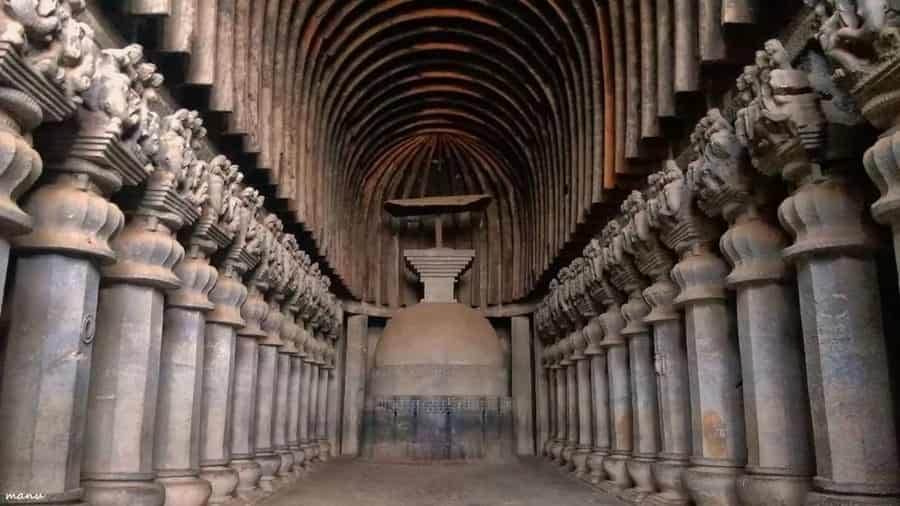
The Karla Caves, located amidst the picturesque Western Ghats, are a remarkable showcase of Buddhist architecture and spirituality. At the heart of this cave complex lies the Great Chaitya, a massive prayer hall that leaves visitors in awe of its size and grandeur. The intricately carved pillars, adorned with motifs and inscriptions, reflect the artistic finesse of the time. As you stand beneath the towering stupa, you can’t help but feel the reverence that this place has held for centuries.
Beyond the architectural marvels, the Karla Caves offer a serene environment for introspection and meditation. The tranquil surroundings, with the sound of birds and rustling leaves, create an ambiance conducive to inner peace. The caves also provide insights into the Buddhist way of life, with chambers that likely served as residences for monks. Visiting the Karla Caves is not just a journey through history but also an opportunity to connect with the spiritual essence that pervades this site.
Bhaja Caves: A Hike into History
Location: Maharashtra
Just a stone’s throw away from the Karla Caves lies the Bhaja Caves, offering an equally enthralling experience. These caves, dating back to the 2nd century BCE, are known for their beautifully carved facades and Chaitya halls. As you hike up to reach these caves, you’ll be rewarded with not just historical riches but also panoramic views of the surrounding landscape.
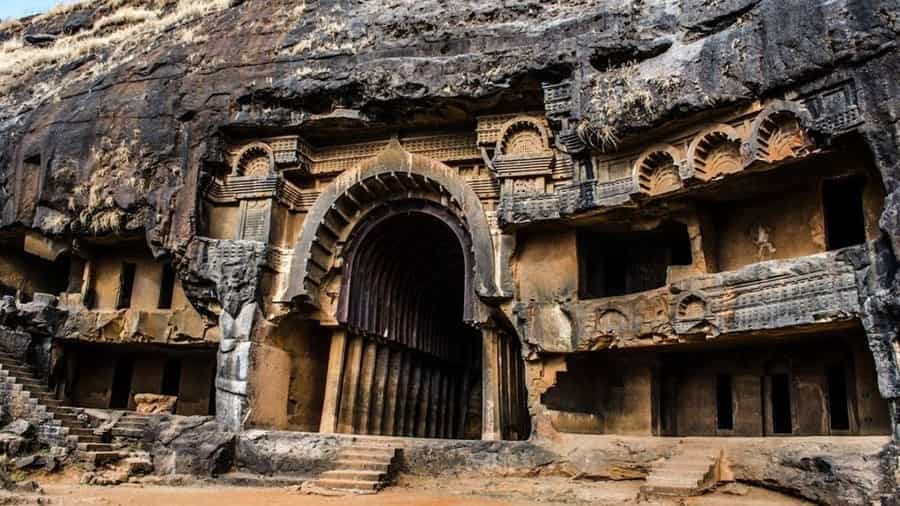
The Bhaja Caves, situated in close proximity to the Karla Caves, are a hidden gem for history enthusiasts and nature lovers alike. What sets these caves apart is the journey to reach them—a picturesque hike through the lush Western Ghats. As you ascend towards the caves, the anticipation builds, and when you finally arrive, the intricately carved facades and the serene Chaitya halls captivate your senses. These caves provide a glimpse into the religious practices and artistic talents of the ancient inhabitants.
Besides their historical significance, the Bhaja Caves offer a vantage point to admire the natural beauty of the Western Ghats. From the cave entrances, you can soak in panoramic views of the surrounding hills and valleys. It’s a perfect blend of history and nature, making it an ideal spot for those seeking both intellectual and sensory experiences. The Bhaja Caves remind us that history is not just confined to textbooks; it’s etched into the very rocks and landscapes that surround us.
Bedse Caves: Serenity in Stone
Location: Maharashtra
The Bedse Caves, nestled in the Sahyadri mountains, are a hidden gem waiting to be explored. These caves, predominantly Buddhist, feature intriguing inscriptions and sculptures. Their remote location adds to the sense of serenity that envelops the site.
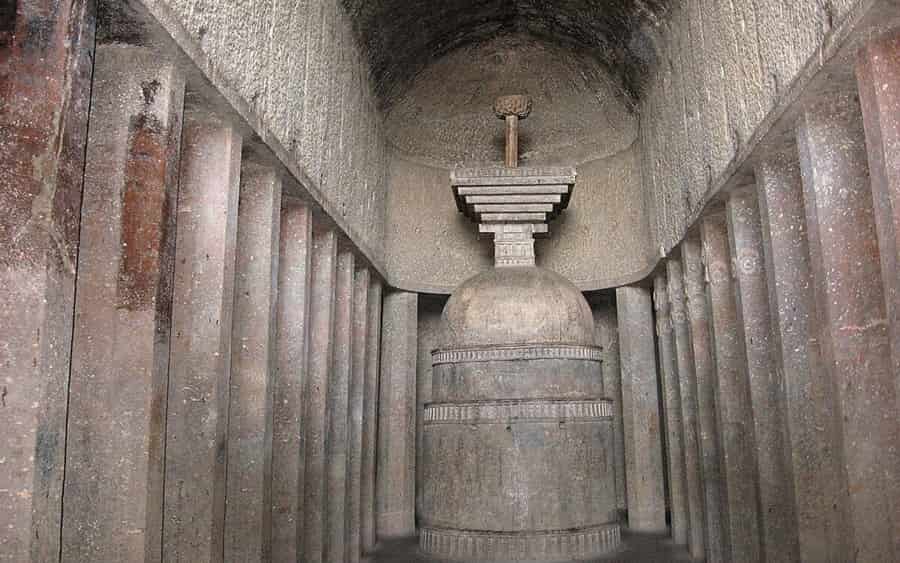
The Bedse Caves, tucked away in the Sahyadri mountains, offer a unique opportunity to explore lesser-known rock-cut wonders. These caves, predominantly Buddhist, hold secrets etched in stone. As you step inside, you’ll encounter intriguing inscriptions and sculptures that provide glimpses into the religious and artistic practices of the past. The remoteness of this site creates an ambiance of serenity, making it an ideal place for contemplation and quiet exploration.
Beyond their historical and artistic significance, the Bedse Caves serve as a reminder of the enduring legacy of Buddhism in India. These rock-cut chambers, though less frequented by tourists, have stood the test of time, bearing witness to the devotion of ancient monks. Visiting the Bedse Caves is like embarking on a journey of discovery, where each carving and inscription tells a story waiting to be deciphered. It’s a place where history and tranquility converge, offering a unique experience for those willing to venture off the beaten path.
Kanheri Caves: Monastic Abode
Location: Maharashtra
Located within the bustling city of Mumbai, the Kanheri Caves are a testament to the monastic life of ancient India. These caves served as a prominent Buddhist center, and their rock-cut chaityas and viharas bear witness to the spiritual pursuits of the monks who resided here. Exploring these caves is like taking a step back in time amidst the urban chaos.
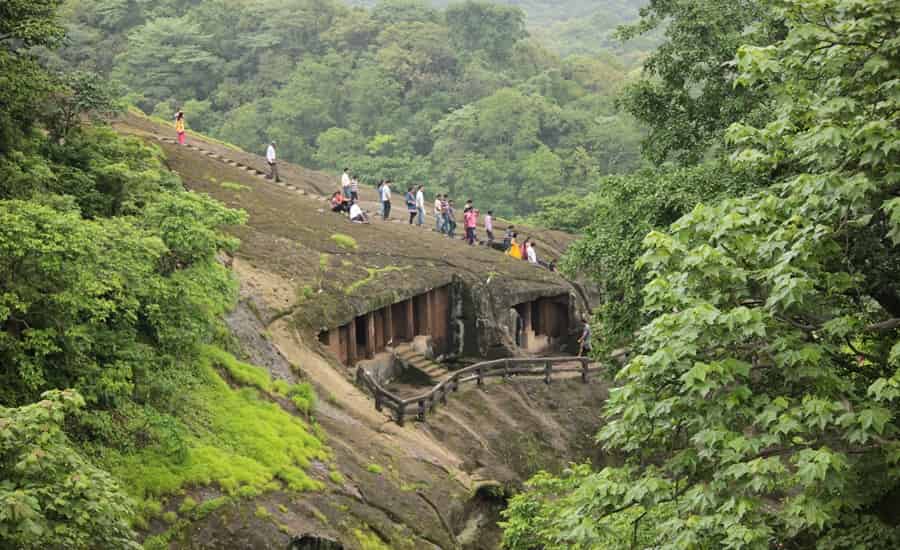
The Kanheri Caves, nestled within the bustling city of Mumbai, offer a unique juxtaposition of ancient serenity within a modern metropolis. These caves, dating back to the 1st century BCE, served as a thriving Buddhist center, attracting monks and devotees from far and wide. The rock-cut chaityas (prayer halls) and viharas (residential cells) within the caves are a testament to the monastic life that once thrived here. As you walk through these dimly lit chambers, you can almost hear the echoes of ancient chants and feel the spiritual aura that still lingers.
Beyond their historical and religious significance, the Kanheri Caves provide a tranquil escape from the urban hustle and bustle. The lush green surroundings and the sound of chirping birds create an ambiance of peace and contemplation. The rock-cut sculptures and inscriptions found within the caves offer insights into the daily lives of the monks who resided here. It’s a place where spirituality and history intersect, providing a serene retreat for those seeking solace amidst the chaos of the city.
Undavalli Caves: Gupta Artistry
Location: Andhra Pradesh
The Undavalli Caves, perched atop a hill near Vijayawada, showcase the artistic prowess of the Gupta Empire. These caves, with their colossal reclining Vishnu statue and intricate carvings, are an ode to Hindu mythology. The cave complex also boasts a peaceful vihara with ornate pillars.
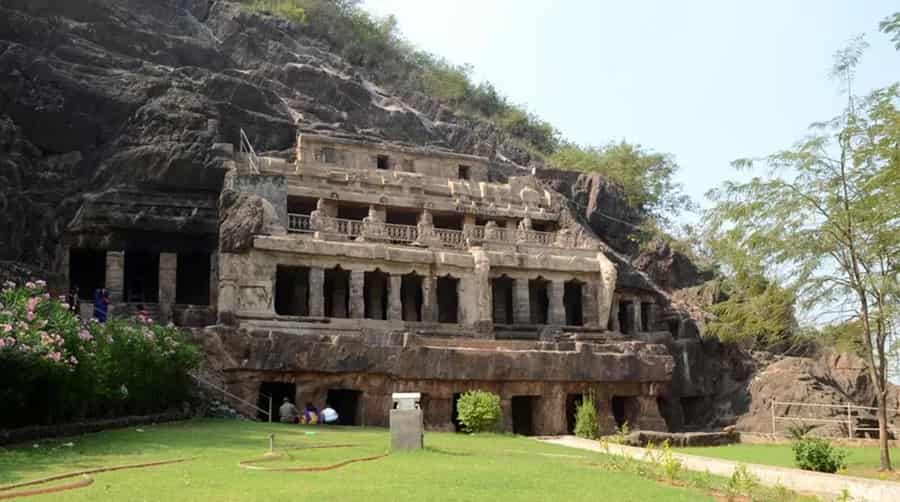
The Undavalli Caves, located in the picturesque state of Andhra Pradesh, are a testament to the artistic finesse that flourished during the Gupta Empire. Perched atop a hill overlooking the Krishna River, these caves are a visual delight. The star attraction is the colossal reclining statue of Lord Vishnu, an architectural marvel in itself. The intricate carvings on the cave walls narrate stories from Hindu mythology, bringing the epics to life. As you explore these caves, you’ll be immersed in the rich tapestry of ancient Indian storytelling and artistry.
Beyond their artistic beauty, the Undavalli Caves offer a serene atmosphere for reflection and contemplation. The vihara, or monastery, within the cave complex provides a peaceful retreat where one can admire the ornate pillars and find solace amidst the historical riches. The caves, with their panoramic views of the surrounding landscape, offer a sense of harmony with nature, making it a place where art, spirituality, and natural beauty converge.
Pandavleni Caves: Buddhist Retreat
Location: Maharashtra
The Pandavleni Caves, situated in Nashik, offer a tranquil escape into Buddhist history. These caves, dating back to the 1st century BCE, are adorned with inscriptions, sculptures, and chaitya halls. Exploring these caves is like unraveling a treasure trove of ancient wisdom.
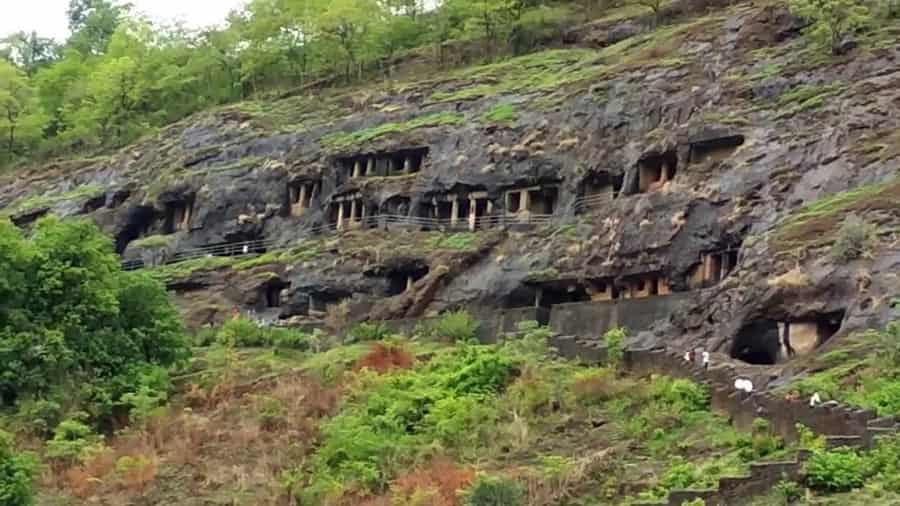
The Pandavleni Caves, nestled in the hills of Nashik, provide a serene retreat into the world of Buddhism. These caves, dating back to over two thousand years, served as monastic residences for Buddhist monks. The intricately carved facades, adorned with motifs and inscriptions, provide glimpses into the religious and artistic practices of ancient India. As you ascend the stone steps and explore the cave complexes, you can sense the spiritual energy that still resides within these ancient chambers.
Beyond their historical significance, the Pandavleni Caves offer an opportunity for introspection and contemplation. The tranquil surroundings, with the rustling of leaves and the sound of flowing water, create an ambiance of serenity. The chaitya halls, with their stupa and sculpted panels, invite you to connect with the spiritual essence that has permeated this site for centuries. Visiting the Pandavleni Caves is not just a journey through time but also a chance to tap into the ancient wisdom and tranquility that this place exudes.
- Suggested Tour: India Buddhist Pilgrimage Tour Packages
Edakkal Caves: Ancient Petroglyphs
Location: Kerala
The Edakkal Caves in Kerala provide a unique experience. These caves are not your typical rock-cut temples but rather natural formations with petroglyphs that date back over 5,000 years. Exploring these caves is like deciphering a prehistoric message etched into the very rocks.
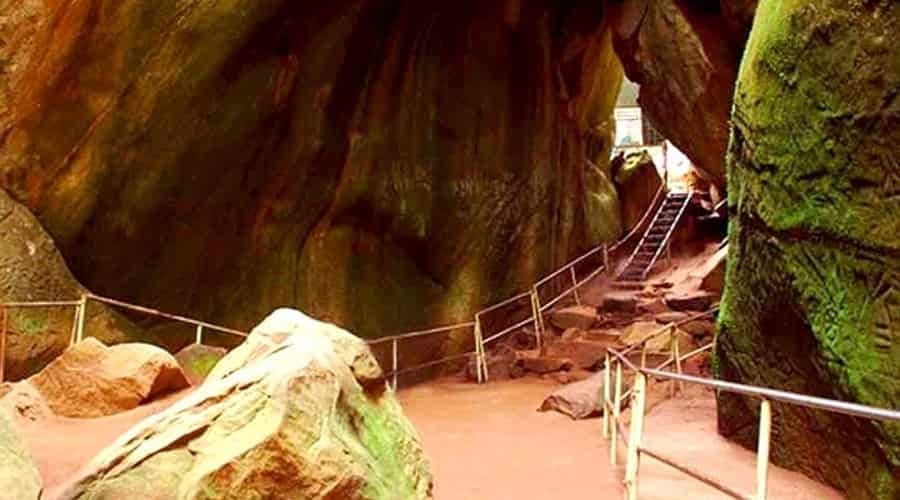
The Edakkal Caves, nestled in the Wayanad district of Kerala, offer a glimpse into the ancient past like no other. Unlike traditional rock-cut caves, these natural formations are adorned with petroglyphs and pictorial carvings that date back thousands of years. As you venture into the caves, you’ll encounter inscriptions and images that offer a tantalizing glimpse into the lives and beliefs of ancient inhabitants. It’s like unraveling a prehistoric storybook etched in stone.
Beyond their historical and archaeological significance, the Edakkal Caves offer a unique opportunity for exploration and adventure. To reach the caves, visitors must embark on a trek through lush forests and rugged terrain. The journey itself is an exhilarating experience, culminating in the discovery of these ancient wonders. The caves, with their panoramic views of the Western Ghats, provide a sense of connection to a distant era, making it a must-visit destination for history enthusiasts and nature lovers alike.
Conclusion
India’s rock-cut cave temples are not just architectural marvels; they are windows into the past, narrating stories of faith, artistry, and cultural exchange, making them integral to the India pilgrimage experience. Visiting these sites is akin to stepping into a time machine that transports you to eras long gone. From the intricately carved Badami Caves in Karnataka to the mysterious Edakkal Caves in Kerala, each cave complex has its unique charm and historical significance.
Exploring these treasures, immersing yourself in their history, and witnessing the enduring legacy of India’s rich heritage is a journey worth undertaking. Whether you seek spirituality, artistic inspiration, or a deeper connection with history, India’s rock-cut cave temples offer it all.
So, plan your journey, pack your curiosity, and set out to discover these remarkable sites that have withstood the test of time. The echoes of ancient chants and the stories etched in stone await your exploration.
FAQs
Q- 1 Are photography and videography allowed inside these cave temples?
Most cave temples allow photography, but it’s essential to check the rules and regulations at each site. Some may have restrictions to preserve the artwork.
Q- 2 Is there an entrance fee to visit these caves?
Yes, most of these cave complexes have an entrance fee. The fee varies from site to site and may also depend on your nationality.
Q- 3 Are these caves accessible for people with mobility issues?
Accessibility varies at each cave complex. Some may have ramps and facilities for visitors with mobility challenges, while others may not be as accommodating.
Q- 4 What is the best time to visit these cave temples in India?
The ideal time to visit these caves is during the cooler months, from October to March, to avoid extreme heat and monsoon rains.
Q- 5 Are there guided tours available at these cave temple sites?
Yes, many cave temple complexes offer guided tours, which can enhance your understanding of the history and significance of these sites. It’s advisable to check in advance and book if necessary.
Now that you’ve had a glimpse of these remarkable rock-cut cave temples in India, it’s time to plan your journey and experience their beauty firsthand.

 Call
Call WhatsApp
WhatsApp Enquiry
Enquiry